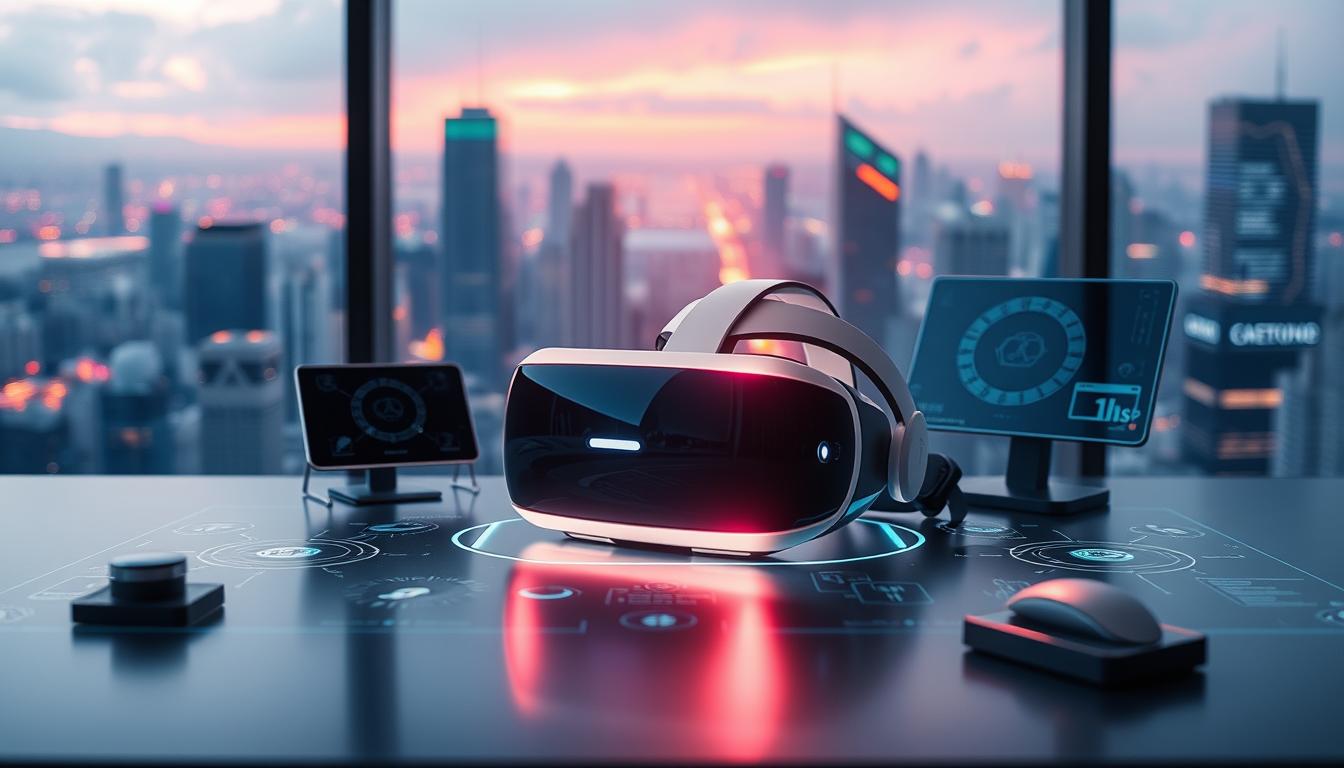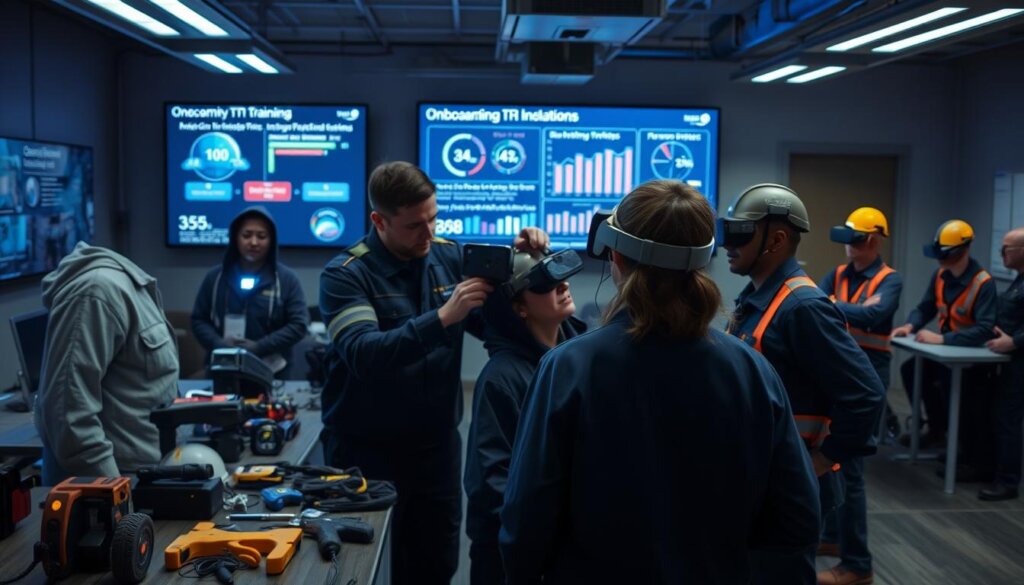Imagine a new technician walking into a manufacturing facility on their first day. Instead of flipping through binders or shadowing overworked colleagues, they slip on a headset. Suddenly, they’re inside a virtual workspace, practicing equipment repairs with holographic guidance. Mistakes vanish with a reset button. Confidence grows faster than ever. This isn’t sci-fi—it’s how modern companies are redefining employee integration.
Traditional training methods often leave teams scrambling. Paper manuals gather dust. Live demos eat up resources. But immersive technologies are flipping the script. One logistics company reported cutting new-hire preparation from six weeks to three—without sacrificing quality. Another saw a 40% jump in retention simply by making learning interactive.
Why does this matter? Engaged employees stay longer. Efficient training saves money. And in technical roles, where safety and precision are non-negotiable, hands-on virtual practice reduces real-world risks. We’ll show you how industry leaders design programs that stick, using tools that adapt faster than any PowerPoint deck ever could.

Key Takeaways
- Immersive learning tools reduce technical skill development time by half
- Interactive programs boost employee retention rates by 40%
- Virtual practice environments minimize operational risks during training
- Businesses report 30% cost savings compared to traditional methods
- Scalable solutions maintain consistency across global teams
The Evolution of Employee Onboarding with AR and VR
Remember when starting a new job meant drowning in paperwork and coffee-stained manuals? The journey from those cluttered desks to today’s sleek headsets reveals how workplace integration has transformed. Modern tools now turn orientation into dynamic exploration rather than a chore.
From Paper Trails to Digital Pathways
Early orientation relied on printed guides and in-person shadowing. New team members often felt lost in jargon-filled binders. While digital modules later replaced some paperwork, click-through slides still left many disconnected from real-world tasks.
Breaking Ground With Interactive Learning
The real shift came when virtual reality allowed practice without pressure. Imagine mastering complex equipment through 3D models instead of diagrams. One automotive manufacturer found trainees learned safety protocols 60% faster using immersive simulations.
Today’s tools create two-way conversations. Fresh hires troubleshoot virtual scenarios while receiving instant feedback. This active learning-by-doing approach builds muscle memory and confidence faster than any lecture. Companies now design customized journeys that adapt to individual progress, making skill development feel personal rather than robotic.
These advancements aren’t just about flashy tech—they’re reshaping how teams grow. By blending digital innovation with human-centered design, businesses craft memorable experiences that stick long after day one.
Key Benefits of AR/VR Onboarding
What if your team could master complex tasks while feeling like they’re playing a game? Modern workforce development tools turn this idea into reality, delivering measurable advantages that old-school methods struggle to match.

Enhanced Engagement and Employee Retention
Three-quarters of learners using digital simulations report “lightbulb moments” during sessions. This active participation creates emotional connections to material—something PDFs rarely achieve. When people engage deeply with content, they’re 40% more likely to stay with their employer long-term.
Early experiences shape loyalty. Since most workers decide their commitment within six months, dynamic learning environments become retention engines. Teams trained through interactive scenarios often outperform peers while building stronger ties to company goals.
Cost-Effectiveness and Resource Efficiency
Gone are the days of booking conference rooms or flying trainers across states. One aerospace company slashed training budgets by 55% using reusable 3D modules. Digital tools eliminate printing costs, equipment rentals, and venue fees—freeing funds for innovation.
Scalability transforms resource allocation. A single simulation can onboard hundreds simultaneously, maintaining consistency across global offices. Reduced turnover compounds savings—every retained worker avoids $15,000+ in replacement costs. It’s not just about cutting expenses; it’s about investing smarter.
Step-by-Step Guide to Implementing AR/VR Onboarding
Think about streamlining your team’s first days with a blueprint that works smarter, not harder. Successful integration begins with strategic planning and evolves through thoughtful technology choices.
Planning and Program Design
Start by mapping your current training gaps. Are new hires struggling with equipment protocols? Do regional teams receive inconsistent instruction? Define measurable goals like reducing ramp-up time or standardizing safety demonstrations.
Audit existing materials to identify where interactive learning-by-doing adds value. A food manufacturer discovered that 70% of orientation errors occurred during machinery demonstrations—a perfect candidate for virtual practice modules.
Selecting the Right Digital Solutions
Choose a platform that grows with your needs. Web-based systems like iQ3Connect eliminate software headaches while letting teams build 3D simulations using existing CAD files. No coding? No problem—their drag-and-drop tool turns complex data into interactive content in hours.
Prioritize integration with your HR systems. Single sign-on capabilities and LMS compatibility keep the process seamless. After pilot testing, one energy company rolled out global safety certifications 3x faster by connecting their new technologies to employee databases.
Remember: The best programs evolve. Schedule quarterly reviews to refresh scenarios and align with updated workflows. Your future team will thank you.
Addressing Common Onboarding Challenges with AR and VR
What happens when first-day jitters meet cutting-edge tech? Traditional methods often drown newcomers in dense manuals and one-size-fits-all lectures. Modern tools flip this script by transforming obstacles into stepping stones for growth.

Overcoming Engagement and Information Overload
Ever felt buried under an avalanche of paperwork? New team members frequently face this during orientation. Interactive modules solve this by letting people learn through bite-sized scenarios they control. Instead of memorizing steps, they troubleshoot virtual systems—retaining 60% more information according to recent studies.
Passive listening becomes active problem-solving. Trainees reset mistakes instantly, building confidence without judgment. This approach keeps minds focused and curiosity alive from day one.
Delivering Hands-on Training Safely
Real-world practice isn’t always safe or practical. Virtual environments let people operate heavy machinery or handle chemicals risk-free. One chemical plant reduced equipment damage by 75% using simulated spill drills.
These solutions also erase geographical barriers. Teams in different cities practice identical procedures simultaneously, ensuring uniform skill development. Mistakes become lessons rather than liabilities, creating safer workplaces through repetition.
Customer Success Stories & Industry Insights
Success leaves clues, and industry pioneers are charting the path forward. Organizations across sectors now prove that smart implementation drives real results. Let’s explore how visionaries turn challenges into triumphs.
Case Studies from Leading Companies
Walmart transformed workforce development by deploying virtual simulations across 4,600 locations. Over one million associates now practice customer service scenarios and inventory management in risk-free environments. “The scalability surprised us,” admits a senior operations manager. “Same quality from New York to Nebraska.”
Accenture’s Nth Floor platform reimagines orientation. New hires navigate 3D office replicas, chatting with holographic colleagues. This approach slashed orientation time by 35% while boosting early retention rates. Meanwhile, Jaguar Land Rover engineers master complex systems in days rather than weeks through interactive modules.
Comparing Traditional and Immersive Experiences
Companies like Hilton Hotels reveal striking contrasts. Where paper manuals once caused inconsistent service, virtual reality now delivers uniform standards globally. Honeywell’s remote machine operation training eliminated travel costs while improving safety scores by 22%.
Business leaders emphasize measurable differences. C M Venkat from Aker Solutions notes, “Our teams achieve 90% competency faster through simulated reviews.” Compared traditional classroom sessions, immersive programs show 40% better knowledge retention—proof that modern methods create lasting impact.
These examples demonstrate a clear pattern: when learning feels alive, training outcomes improve exponentially. The numbers don’t lie—neither do the smiling faces of confident new hires.
Technical Know-How: AR/VR Onboarding in Technician Training
In high-stakes technical roles, precision isn’t optional—it’s everything. Modern tools bridge the gap between classroom theory and real-world execution, giving teams room to grow without operational risks.
Simulated Hands-on Training Scenarios
Step-by-step virtual guides transform complex repairs into manageable tasks. New hires disassemble 3D equipment models, receiving instant feedback. This builds critical skills faster—one manufacturer cut error rates by 65% during probation.
Integrating Safety and Security Protocols
Digital environments let teams rehearse emergency responses. Employees practice fire evacuations in burning virtual facilities or master lockout-tagout procedures. These drills create reflexive safety habits that protect both people and assets.
Consistency matters across global operations. Identical modules ensure every team follows the same protocols, reducing compliance gaps. When expertise meets innovation, everyone wins.
See how FieldAx can transform your Field Operations.
Try it today! Book Demo
You are one click away from your customized FieldAx Demo!
FAQ
How does immersive technology improve employee retention during onboarding?
Immersive learning environments boost engagement by making training interactive and memorable. Companies like Walmart and Boeing report higher retention rates because employees practice real-world skills in risk-free simulations, building confidence faster than traditional methods.
What industries benefit most from hands-free training tools?
High-risk sectors like manufacturing, healthcare, and energy gain significant advantages. For example, Siemens Healthineers uses virtual scenarios to train technicians on complex machinery, reducing errors and improving safety outcomes without physical equipment.
Can immersive programs reduce onboarding costs for small businesses?
Yes. While initial setup requires investment, scalable platforms like Strivr lower long-term expenses by minimizing travel, material waste, and instructor time. UPS saved over M annually by switching to virtual training modules for drivers.
How do simulated environments address information overload?
Bite-sized, scenario-based learning lets employees absorb content gradually. KFC’s virtual training gamifies kitchen processes, breaking complex tasks into digestible steps that improve knowledge retention by 70% compared to manuals.
Are there measurable performance gains with immersive onboarding?
Absolutely. Airbus saw a 50% drop in assembly errors after introducing AR-guided workflows. Real-time feedback in virtual settings helps learners correct mistakes instantly, accelerating skill mastery and productivity.
What safety features do these technologies offer for technical roles?
Platforms like PixoVR include emergency protocols and hazard simulations. Utility workers at Duke Energy practice responding to virtual electrical faults, ensuring they’re prepared for real-world challenges without physical risks.
How quickly can companies adapt existing onboarding content to immersive formats?
With tools like Talespin, teams convert traditional materials into interactive modules in weeks. Verizon redesigned its retail onboarding in under a month, using mixed reality to simulate customer interactions and sales scenarios.
Author Bio
Co-Founder & CMO at Merfantz Technologies Pvt Ltd | Marketing Manager for FieldAx Field Service Software | Salesforce All-Star Ranger and Community Contributor | Salesforce Content Creation for Knowledge Sharing






